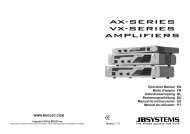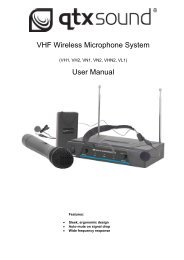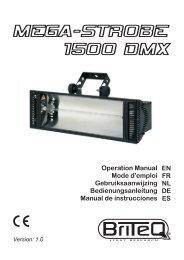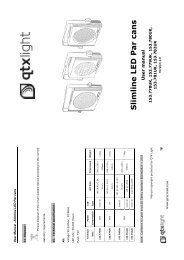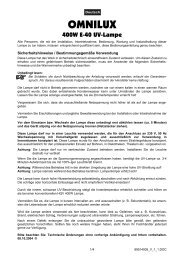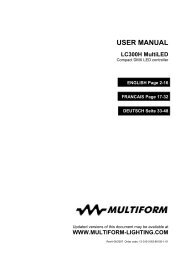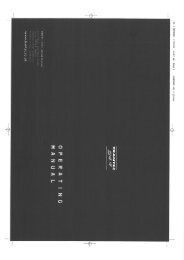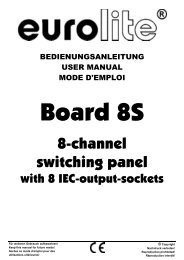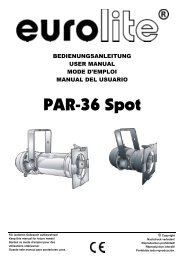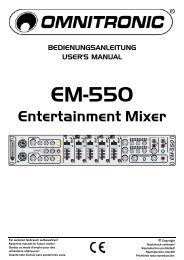Sound Processor
Sound Processor
Sound Processor
You also want an ePaper? Increase the reach of your titles
YUMPU automatically turns print PDFs into web optimized ePapers that Google loves.
Proel <strong>Sound</strong> <strong>Processor</strong>s User Manual<br />
Valore N del control change 16=Tabella n° 5<br />
Par 3:<br />
Cyl PEQ F: Indica la frequenza che verrà enfatizzata/attenuata tramite il Cyl PEQ G dell’ equalizzatore del clilindro.<br />
Range: 20hz-20Khz in step da un terzo d’ottava.<br />
Valore N del control change 17=2<br />
Valore N del control change 16=Tabella n° 4<br />
Par 4:<br />
Cyl PEQ Q: indica lo spettro di frequenze intorno quella principale selezionata (Cyl PEQ F), che verrà modificato<br />
dal Cyl PEQ G. Range: 0.050 Ottave – 3 Ottave, in step di 0.050. Più piccolo sarà il valore di Q, più “selettivo” sarà<br />
il filtro.<br />
Valore N del control change 17=3<br />
Valore N del control change 16=Tabella n° 7<br />
Par 5:<br />
Horn PEQ G:<br />
Indica il guadagno o l’attenuazione (+/– 15 dB in step da 0.5 db) dell’equalizzatore della tromba .<br />
Valore N del control change 17=4<br />
Valore N del control change 16=Tabella n° 5<br />
Par 6:<br />
Horn PEQ F: Indica la frequenza che verrà enfatizzata/attenuata tramite il Horn PEQ G dell’ equalizzatore del<br />
clilindro. Range: 20hz-20Khz in step da un terzo d’ottava.<br />
Valore N del control change 17=5<br />
Valore N del control change 16=Tabella n° 4<br />
Par 7:<br />
Horn PEQ Q: indica lo spettro di frequenze intorno quella principale selezionata (Horn PEQ F), che verrà<br />
modificato dal Horn PEQ G. Range: 0.050 Ottave – 3 Ottave, in step di 0.050. Più piccolo sarà il valore di Q, più<br />
“selettivo” sarà il filtro.<br />
Valore N del control change 17=6<br />
Valore N del control change 16=Tabella n° 7<br />
Par 8:<br />
PEQ G:<br />
Indica il guadagno o l’attenuazione (+/– 15 dB in step da 0.5 db) dell’equalizzatore generale.<br />
Valore N del control change 17=7<br />
Valore N del control change 16=Tabella n° 5<br />
Par 9:<br />
PEQ F: Indica la frequenza che verrà enfatizzata/attenuata tramite il PEQ G dell’ equalizzatore del effetto. Range:<br />
20hz-20Khz in step da un terzo d’ottava.<br />
Valore N del control change 17=8<br />
Valore N del control change 16=Tabella n° 4<br />
Par 10:<br />
PEQ Q: indica lo spettro di frequenze intorno quella principale selezionata (PEQ F), che verrà modificato dal PEQ<br />
G. Range: 0.050 Ottave – 3 Ottave, in step di 0.050. Più piccolo sarà il valore di Q, più “selettivo” sarà il filtro.<br />
Valore N del control change 17=9<br />
Valore N del control change 16=Tabella n° 7<br />
CHORUS REVERB<br />
Par 1:<br />
Chorus rate: indica la profondità del chorus. Range: da 0-100%<br />
Valore N del control change 17=0<br />
Valore N del control change 16=da 0 a 100<br />
Par 2:<br />
% Vol Chorus: indica il volume generale dell’effetto. Range: da 0-100%<br />
Valore N del control change 17=1<br />
Valore N del control change 16=da 0 a 100<br />
13



